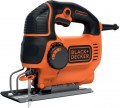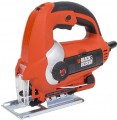Minimum frequency
The minimum stroke frequency of the jigsaw blade during operation. In some cases (for example, when working on metal), a low stroke rate is preferable to a high one; accordingly, the lower the minimum frequency, the more opportunities you will have to set up the instrument for working on a particular material.
Max. frequency
The maximum stroke frequency of the jigsaw blade during operation. The
higher the stroke rate, the higher the performance of the tool and the cleaner and more accurate the cut, usually. On the other hand, high speed is not optimal for all materials; picking up a "high-speed" jigsaw is worth it if it is planned to be used mainly for woodworking.
Also note that the characteristics of the tool usually indicate the maximum frequency at idle; at work, it is usually less. However, this parameter quite allows you to compare different tools with each other.
Stroke
The length of the stroke of the working blade of the jigsaw during operation. The longer the stroke, the more of the file will be in contact with the material in one movement; accordingly, at the same frequency of movement of the blade, a jigsaw with a longer stroke length will be more performant.
Wood
Maximum cutting depth in wood, in other words — the maximum thickness of a wooden workpiece that a jigsaw can handle. This parameter characterizes not only directly the maximum thickness of the material, but also the performance of the tool as a whole: the greater the depth of cut, the higher the performance. In the case of wood for domestic use, a depth of about 70 mm is considered sufficient, deeper models are usually professional.
It is worth noting that the depth of cut is usually indicated for certain files recommended by the manufacturer for a particular material. The use of other canvases does not guarantee compliance with the claimed parameters, and in some cases it is even fraught with breakdowns and injuries.
Aluminium
The maximum cutting depth when working on aluminium and its alloys, in other words, the maximum thickness of a workpiece made of these materials that a jigsaw can cut through. In general, aluminium and its alloys are softer than steel, and therefore the depth of cut through them is greater - in professional models it can reach 30 mm.
Steel
The maximum depth of cut in steel, in fact, is the maximum thickness of a workpiece made of steel or other metal of similar characteristics that a jigsaw can handle. For more information about the depth of cut, see "Wood", here we note that due to the hardness of the material, even in professional models, this parameter rarely exceeds 10 mm.
In box
- Charger. A device for charging the batteries used in the tool with the appropriate power supply. For models supplied with such a device, the charger model may be additionally specified in the characteristics. This information can be useful not only for finding a spare or replacement charger, but also in case the household has other cordless tools and / or batteries for them. On the other hand, a lot of modern cordless tools come without a charger at all. This option will be optimal, first of all, if a compatible memory is already available, and there is simply no need to overpay for a second device. In addition, the lack of a charger will be appreciated by those who want to choose this accessory separately, without relying on the manufacturer's decision.
-
Rubberized handle. The presence of a rubber pad on the handle of the jigsaw. Rubber provides a more secure hold on the tool than plastic, and also helps reduce vibration transmitted to the operator's hands. In some models, rubber pads are made corrugated - for additional reliability.
-
Protective shield. The presence in the design of the jigsaw of a transparent (usually plexiglass) protective shield in the front, near the file. It prevents fine sawdust from being scattered during operation, and also improves blowing or suction efficiency (if these functions are present, see "Functions/Features" for more details). In most cases, the p
...rotective shield is made removable.
- Case included. The presence of a special suitcase-case in the delivery set of the jigsaw. Such a case greatly facilitates storage and transportation, because. initially “sharpened” for a specific jigsaw model. In addition, additional accessories can usually be stored in it: replacement files, a tool for changing them (if required), a spare battery, etc.
- Flexible shaft. The flexible shaft is a special kind of auxiliary nozzle. Outwardly, this device looks like a hose, sometimes quite long. One end of such a "hose" is attached to the cartridge, and the other has its own cartridge, where the working nozzle is attached - rotation is transmitted to it due to the shaft located inside the "hose". The part of the flexible shaft held in the hands during operation is more compact and lighter than the jigsaw itself, so the most popular ways to use such equipment are the processing of hard-to-reach places (where the tool simply cannot crawl through) and fine work (which is difficult to do with a massive machine).
- Pedal. The presence of the pedal frees the hands of the master and allows you to adjust the speed of rotation of the nozzle by changing the pressure on the pedal. The dependence here is directly proportional - the stronger the pressure, the higher the speed.
